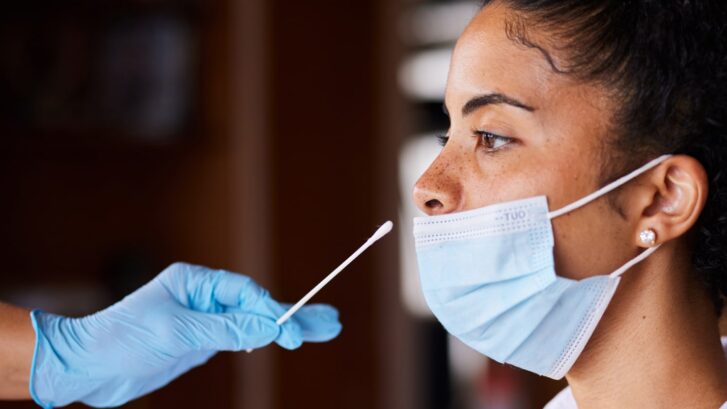Yes, COVID-19 Remains a Threat
Our primary care concierge doctors in Jupiter dislike being the bearers of bad news, but it’s important to know that the COVID-19 virus is still active, still mutating, and still killing people: as many as 250 Americans a day, primarily those who are immunocompromised and older adults.
That equals roughly 90,000 of us every year. This figure is well below the height of the pandemic when 4,000 Americans a day were dying. But the number isn’t insignificant if it impacts you or someone you love.
It’s also important to remember that, even if an infection doesn’t result in death, the long-term consequences even for younger, healthy people can be severe and/or debilitating.
Newest Variant
The latest omicron subvariant, XBB.1.5, now accounts for nearly 80 percent of COVID-19 cases being diagnosed in the U.S., according to the Centers for Disease Control and Prevention (CDC).
In addition, the World Health Organization has identified a new subvariant, XBB.1.16, known as Arcturus. The CDC reported last month that it is now responsible for about seven percent of coronavirus infections, up from about four percent the previous week.
The good news is that Arcturus doesn’t appear to be any more deadly than previous omicron variants. While a change in the spike protein might mean it could spread more rapidly, there’s no indication that cases will be more severe.
“We’ve seen this in the past,” Paul Hunter, a professor of medicine at the University of East Anglia in Britain, told The Washington Post.
“You look at the virus and it’s got mutations that should make it more virulent, but then, in reality, you don’t see that,” he said.
“It will probably become the dominant variant for a while in the U.S. and Europe and most countries around the world, but I don’t see it driving up severe infections more than we’ve seen in recent waves,” he added.
Still Dangerous
That doesn’t mean Arcturus or the currently dominant XBB.1.5 are benign, however.
COVID-19 remains the third leading cause of death in the U.S. Florida is currently seeing 17 new cases every day per 100,000 population, the highest in the nation (Kentucky is second, at 13 new cases per day per 100,000).
These numbers are likely undercounted because so many people have abandoned getting officially tested for COVID-19, are testing at home and not reporting positive cases, or not getting tested at all.
And it’s not just older Americans who are impacted. The CDC reported last month that the 18-29-year-old age group “has accounted for the largest cumulative number of COVID-19 cases compared to other age groups.”
NBC’s Today Show recently reported on a new study by Cedars Sinai Hospital in Los Angeles, which found that the age group hit hardest by post-COVID-19 heart attack deaths was people between 25 and 44. This cohort saw a 29.9 percent relative increase in heart attack deaths over the first two years of the pandemic.
“Young people are obviously not really supposed to die of heart attack,” Susan Cheng, a cardiologist at Cedars Sinai and co-author of the study, told Today in February.
“They’re not really supposed to have heart attacks at all,” she said.
In addition, a National Center for Health Statistics survey showed that nearly 20 percent of adults who had a COVID-19 infection continue to have the debilitating symptoms of long COVID.
Remember the Vulnerable
Unfortunately, most of America seems to have moved on from the pandemic. People are going about their lives as if SARS-CoV-2 was just a bad dream they’re happy to have awakened from.
“Get all the shots you wish, take all the precautions you wish, but the health of us out there are done sacrificing for the weakest of health or brain,” wrote one anonymous commenter last month on The Post website.
This attitude of “stay home forever” rankles journalist Jeanine Santucci, as she recently wrote in USA Today.
A young mother with type 1 diabetes, she is at higher risk from COVID-19. She is fully vaccinated and has loosened her self-quarantine over the past three years, now seeing friends outdoors unmasked if they have a negative COVID-19 test. She ventures out in public with an N95 mask and a portable air purifier but resents the general lack of masking in indoor public spaces.
But she called the “stay home if you’re at risk” approach “cruel” and unfair.
“The main reason I am still taking this seriously, and I hope you will, is that our country’s most vulnerable people deserve to be part of society,” she said.
Protect Yourself and Others
“With the removal of mask mandates in health care settings and essential places such as pharmacies, public transit, and grocery stores, immunocompromised people are made outcasts,” Santucci added.
“But simply putting on an N95 when you go out makes us safer. It shows us you care that we’re alive.”
Given the prevailing attitudes from both government and the general public that if you want to avoid getting COVID-19 you’re pretty much on your own, we recommend continuing to take precautions when you’re in public spaces.
This means any place that is not well-ventilated, including your own home if you have visitors whose infection status is unknown. Wear a mask in crowded settings, and stay up to date on your vaccinations.
As Santucci wrote, “I hope you’ll take into consideration just how much is at stake for you, and the fact that you’re also making a risk calculation for vulnerable people like me when you do.”

